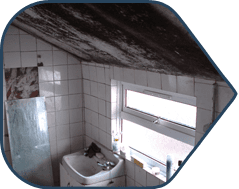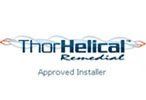Condensation Control
Condensation - an Increasing Problem
The presence of a damp proof course will not prevent condensation dampness. An inadequate balance between heating, ventilation and insulation generally causes condensation. Condensation dampness is a condition that affects many homes and is the major cause of environmental dampness within a property. Condensation is particularly common in homes where there is an inadequate balance between heating, ventilation and insulation. The problems regarding condensation will get much worse during the colder winter months with external walls being particularly at risk.
How does condensation occur?
The air within a property contains a varying amount of moisture vapour. The warm air inside the building will hold more water than cold air. The higher the temperature of the internal air, the more water vapour it can hold. When this air becomes cooled, such as coming into contact with colder air or a colder surface, i.e. cold walls, cold ceiling voids and window panes, it reaches a temperature where it can no longer hold the water vapour. This is often referred to as the ‘dew point’. The ‘dew point’ is the temperature at which condensation will form dependent on the room temperature and relative humidity.
The relative humidity within a property should ideally be between 40%-55%, which would generally be considered a healthy environment. Once the relative humidity begins to increase to 55%-70%, the air quality would begin to deteriorate. At 70%-80% relative humidity the air would be deemed to be poor and occupants may experience tiredness and headaches. It would also heighten the symptoms associated with asthma and respiratory problems. Should the relative humidity exceed 80%, then the air quality would be considered to be very poor and significant mould growth will occur.
Air quality is likely to be worse at night with the relative humidity rising by approximately 5% for every 1º centigrade drop in temperature.
Moisture is released into the air within the home by bathing, cooking, washing and drying of clothes etc. These day-to-day activities produce moisture, which is absorbed into the air (although this cannot be seen). Condensation will generally occur overnight as the fabric of the building cools.
What are the symptoms?
The presence of condensation will lead to staining and mould growth, damaging wallpaper, wall surfaces, window frames, furniture and clothing. The development of mould growth is the most common sign that condensation is present. This mould is generally black, however, it may also be white, yellow or green, depending on the specific type of mould present and the surface material on which it grows. Moisture will also appear on cold surfaces in the form of water droplets or a light ‘mist’.
Moulds are hydrophilic fungi, which means that they require high levels of surface moisture. Capillary held dampness, such as rising dampness is not sufficient to cause mould growth. The mould growth requires free moisture on the surface to germinate.
The mould will produce tiny spores. The moist conditions will also increase the presence of dust mites. This can increase the risk of asthma and respiratory illnesses in some people.
When mould occurs then regular cleaning of the affected surface is vital and should be undertaken using a ‘mouldicide’ or fungicidal wash, which carries a Health and Safety Executive approval number. These cleaning agents should be used only in strict accordance with the manufacturer’s instructions.
Please note that the cleaning of mould will only remove it for a short period of time and it will return to the same position should conditions conducive to the presence of condensation remain within the property.
If mould and mildew has affected clothing and carpets then dry cleaning of clothes may be required to remove mildew. Disturbing the mould by brushing or vacuum cleaning can increase the risk of spore distribution and consequent respiratory problems.
When decorating following mould treatment a good quality fungicidal paint should be used. Please note that this paint is not effective if over coated with ordinary paints, emulsion or wallpaper.
How you can help control condensation?
The use of a dehumidifier can control the airborne moisture and help reduce condensation problems and this may be a good short-term solution. However, it will not solve the cause(s) of the problem. The only way of avoiding severe mould is to eliminate the cause of the dampness – condensation.
Maintaining a reasonable balance between heating, ventilation and insulation can reduce excessive condensation, however, the main source is often the lifestyle of the occupier and a review of this would be necessary if the condensation issues continued.
There are some simple and inexpensive ways of reducing the overall condensation and associated growth of mould in the property, such as:
- Cook with pan lids on and turn the heat down once water has boiled.
- Only use the minimum amount of water for cooking vegetables.
- Never dry laundry on radiators or on ‘clothes horses’ within rooms.
- Install suitable humidity activated mechanical extractor fans to bathrooms and kitchens.
- Dry washing outside where possible or put it in the bathroom with the door closed, ensuring windows are opened or any extractor fan is turned on.
- Ensure tumble driers are vented to the outside.
- Don’t use a gas cooker to heat up your kitchen.
- Don’t use bottled gas heaters, such as Calor or similar, as they produce approximately 8 pints of moisture from an average size gas bottle.
- Keep trickle vents open at all times or alternatively open small window/top lights, as necessary.
- Do not have air vents fitted at low levels.
- Open any high-level air vents.
- Close kitchen and bathroom doors when these rooms are in use, even if the rooms have extractor fans.
- Allow space for the air to circulate in and around furniture.
- Open doors to ventilate cupboards and wardrobes.
- Leave space between the backs of wardrobes and the wall.
- To reduce the risk of mildew on clothes and other stored items in wardrobes, allow air to circulate round them by removing the wardrobe backs or drilling breather holes in them.
- In cold weather the best way to keep rooms warm enough to avoid condensation is to keep a low background heat on all day, even when there is no one at home.
- Draught proofing of windows and doors will help keep the home warmer and therefore condensation is less likely to occur.
- Do not draught proof rooms where there is a fuel-burning heater.
The above is not a definitive list and some items may not relate to all properties, however, if followed where applicable the above points will assist in controlling the occurrence of condensation.
Further Control Measures
If the above measures do not adequately help to control the condensation then we can fit other means of assisted ventilation to a property.
The installation of standard airbricks to the rooms may be of assistance, however, more often than not occupiers may cover these over or close them as they can prove to be draughty. An alternative to the standard airbrick is the installation of a Passyfier vent.
The installation of Passyfier vents into a property can help to control the presence of condensation. Passyfier vents combine a through-the-wall, ‘warm’ telescopic sleeve with a louvered vent at each end and a sloping slab of mineral wool inside. The mineral wool is transparent to the exodus of moisture vapour while simultaneously preventing cold draughts so that occupiers do not block them up. Passyfiers take advantage of the difference in the normally higher partial moisture vapour pressure inside an occupied building than that on the colder outside. These vents reduce draughts entering a property as would be experienced with a standard airbrick.
The installation of Passyfiers should be used as a strategic approach to the control of condensation.
A further alternative to the installation of Passyfier vents would be to consider the installation of a Positive Input Ventilation Unit (PIV). A PIV unit will use lower humidity air from outside to reduce the relative humidity levels within the property and by creating an imperceptible positive pressure will minimise draughts and replace them with controlled ventilation. These units are generally fitted within the roof void, although where no roof is present, such as in flats, then a surface wall mounted unit would be used.
These units should not be seen as a replacement for mechanical ventilation to bathrooms or kitchens. Mechanical ventilation to bathrooms and kitchens should be installed in addition to any other means of condensation control.
The control of condensation is not an exact science and the above recommendations should be used as a guide only.
For an assessment of mould growth issues, please call us on 01227 860 550 or fill in our contact form.
Book now
Thank you for contacting us.
We will get back to you as soon as possible
We will get back to you as soon as possible
Oops, there was an error sending your query.
Please try again later
Anglian Tectonics
The Old Store Church Lane, Chislet, Canterbury,
CT3 4EB
© 2025. The content on this website is owned by us and our licensors. Do not copy any content (including images) without our consent.















